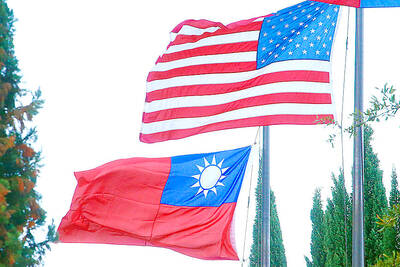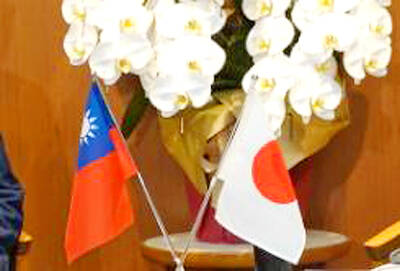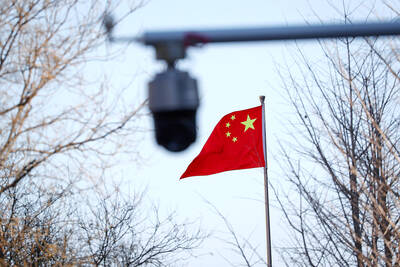A US Department of Defense report on the Chinese military released on Monday briefly criticized Taiwan’s defense spending and its transition to voluntary military service.
The report, Military and Security Developments Involving the People’s Republic of China 2013, said that as the Taiwanese government shifts to a national volunteer force, the freed-up savings and resources are being used for personnel salaries and benefits, but it is “diverting funds from foreign and indigenous [weapons] acquisition programs.”
It said the program did not meet is objective, with a total of 235,000 people inducted into military service in recent years, far below the target of 270,000.
“Taiwan’s military spending has dropped to approximately 2 percent of GDP — well below President Ma’s [Ying-jeou (馬英九)] pledge of 3 percent,” the report said, adding that China’s defense budget is 10 times that of Taiwan.
The annual report to the US Congress covers China’s security and military strategies, as well as the security situation in the Taiwan Strait.
US Deputy Assistant Secretary of Defense for East Asia David Helvey briefed journalists on the report at a press conference at the Pentagon on Monday.
“Over the past year, cross-strait relations have improved. However, China’s military buildup shows no signs of slowing,” Helvey said, adding that China has more than 1,100 short and medium-range ballistic missiles directed at Taiwan.
The range and capability of the missiles are being enhanced, and China is modernizing its conventional and precision-attack weapons deployed against Taiwan, Helvey said.
“China’s overall strategy [toward Taiwan] continues to incorporate elements of persuasion and coercion to deter or repress the development of political attitudes in Taiwan favoring independence,” he said, quoting the report.
“Dealing with a potential contingency in the Taiwan Strait remains the PLA’s [People’s Liberation Army] primary mission ... In this context, should deterrence fail, the PLA would be called upon to compel Taiwan to abandon independence, or to re-unify [sic] with the mainland by force of arms, while defeating any third-party intervention on Taiwan’s behalf,” he said.
The report indicated that the PLA’s ability to attack Taiwan is improving each year, as currently China is unable to totally cut off Taiwan through a maritime blockade.
However, this capability will be substantially improved over the next five to 10 years, he said.
The US Department of Defense added that the PLA’s modernization is based on preparations for a Taiwan conflict with the possibility of US intervention, and that the “Taiwan military’s technological superiority, and the inherent geographic advantages of island defense” are gradually eroding.
The PLA Air Force “has stationed a large number of advanced aircraft within an unrefueled range of Taiwan, providing them with a significant capability to conduct air superiority and ground attack operations against Taiwan,” and “a number of long-range air defense systems provide a strong layer of defense of China’s mainland against a counterattack,” the report said.
“China’s development of support aircraft provide it improved ISR [intelligence, surveillance and reconnaissance] to support PLA Air Force operations in a contingency,” the report said.
In addition, the PLA Navy has developed “a credible at-sea nuclear deterrent, and introducing new platforms that are positioned to strike Taiwan in a cross-Strait conflict” and its new weapons “are designed to achieve sea superiority within the first island chain and counter any third party intervention in a Taiwan conflict,” the report said.
The report’s conclusion said that although progress is being made on cross-strait dialogue, the Taiwanese government and much of the public are not supportive of direct negotiations on issues of Taiwan’s sovereignty.

‘TAIWAN-FRIENDLY’: The last time the Web site fact sheet removed the lines on the US not supporting Taiwanese independence was during the Biden administration in 2022 The US Department of State has removed a statement on its Web site that it does not support Taiwanese independence, among changes that the Taiwanese government praised yesterday as supporting Taiwan. The Taiwan-US relations fact sheet, produced by the department’s Bureau of East Asian and Pacific Affairs, previously stated that the US opposes “any unilateral changes to the status quo from either side; we do not support Taiwan independence; and we expect cross-strait differences to be resolved by peaceful means.” In the updated version published on Thursday, the line stating that the US does not support Taiwanese independence had been removed. The updated

‘CORRECT IDENTIFICATION’: Beginning in May, Taiwanese married to Japanese can register their home country as Taiwan in their spouse’s family record, ‘Nikkei Asia’ said The government yesterday thanked Japan for revising rules that would allow Taiwanese nationals married to Japanese citizens to list their home country as “Taiwan” in the official family record database. At present, Taiwanese have to select “China.” Minister of Foreign Affairs Lin Chia-lung (林佳龍) said the new rule, set to be implemented in May, would now “correctly” identify Taiwanese in Japan and help protect their rights, the Ministry of Foreign Affairs said in a statement. The statement was released after Nikkei Asia reported the new policy earlier yesterday. The name and nationality of a non-Japanese person marrying a Japanese national is added to the

AT RISK: The council reiterated that people should seriously consider the necessity of visiting China, after Beijing passed 22 guidelines to punish ‘die-hard’ separatists The Mainland Affairs Council (MAC) has since Jan. 1 last year received 65 petitions regarding Taiwanese who were interrogated or detained in China, MAC Minister Chiu Chui-cheng (邱垂正) said yesterday. Fifty-two either went missing or had their personal freedoms restricted, with some put in criminal detention, while 13 were interrogated and temporarily detained, he said in a radio interview. On June 21 last year, China announced 22 guidelines to punish “die-hard Taiwanese independence separatists,” allowing Chinese courts to try people in absentia. The guidelines are uncivilized and inhumane, allowing Beijing to seize assets and issue the death penalty, with no regard for potential

‘UNITED FRONT’ FRONTS: Barring contact with Huaqiao and Jinan universities is needed to stop China targeting Taiwanese students, the education minister said Taiwan has blacklisted two Chinese universities from conducting academic exchange programs in the nation after reports that the institutes are arms of Beijing’s United Front Work Department, Minister of Education Cheng Ying-yao (鄭英耀) said in an exclusive interview with the Chinese-language Liberty Times (the Taipei Times’ sister paper) published yesterday. China’s Huaqiao University in Xiamen and Quanzhou, as well as Jinan University in Guangzhou, which have 600 and 1,500 Taiwanese on their rolls respectively, are under direct control of the Chinese government’s political warfare branch, Cheng said, citing reports by national security officials. A comprehensive ban on Taiwanese institutions collaborating or